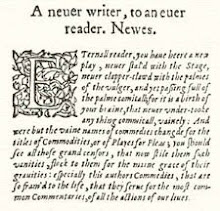
As described in a previous post, there was a profusion of propaganda publications in the spring of 1609, encouraging English persons of all walks of life to emigrate to the New World. Robert Gray's A Good Speed to Virginia, featuring his introduction, dated April 28, 1609, is a remarkable example of this species of book. Not much is known about Preacher Gray, other than the little he reveals in his two known books, both from 1609. (The DNB has no entry on this Robert Gray.) He was a London preacher connected to the Virginia Company. He emerges for this purpose in 1609 and then disappears. Gray's unique spin on the Company's public relations approach was to argue that emigration would solve England's overpopulation problem and provide new opportunities. He wrapped this is the standard Biblical overlay, but adds some piquant racism in dealing with the divine justification for killing natives and stealing their land -- Englishmen were descended from God's Israelites while the New World savages were the devil's spawn. He writes,
"The report goeth, that in Virginia the people are savage and incredibly rude, they worship the devill, offer their young children in sacrifice unto him, wander up and downe like beasts, and in manners and conditions, differ very litle from beasts, hauing no Art, nor science, nor trade, to imploy themselues, or give themselues unto, yet by nature loving and, gentle, and desirous to imbrace a better condition. Oh how happy were that man which could reduce this people from brutishnes, to civilitie, to religion, to Christianitie, to the saving of their soules: happy is that man and blest of God, whom God hath endued, either with meanes or will to attempt this busines, but farre be it from the nature of the English, to exercise any bloudie crueltie amongst these people: farre be it from the hearts of the English, to give them occasion, that the holy name of God, should be dishonoured among the Infidels, or that in the plantation of that continent, they should giue any cause to the world, to say that they sought the wealth of that countrie above or before the glorie of God, and the propagation of his kingdome." [Robert Gray A Good Speed to Virginia 1609]
What is particularly interesting for my study of publications of 1609 is the use of certain language in Gray's dedication to the Adventurers of the Virginia Company.

Note the words: Adventurers, all happie, eternitie, These appear just a few weeks later in Thomas Thorpe's dedication to the mysterious "Mr W. H." in Shake-Speare's Sonnets, published May 1609.
"To. The. Onlie. Begetter. Of. These. Insuing. Sonnets. Mr. W. H. All. Happinesse. And. That. Eternitie. Promised. By. Our. Ever-Living. Poet. Wisheth. The. Well-Wishing. Adventurer. In. Setting. Forth."
And see the image below, Gray's dated sign off, that ends with the words well wishing.
Note also in Gray: time the devourer, memorie, monuments. Strangely, Devouring Time is the theme of Sonnet 19. Memory and Monuments are thematic to Sonnets 55 and 81. Now, I'm not suggesting for a second that Gray's throwaway PR-piece influenced either the Sonnets or the Sonnets dedication. Rather, that a copy of the Sonnets was already making the rounds of the Virginia Company, and Gray (or the man behind that name) was influenced by the Sonnets in manuscript.
There is some scholarship on Gray's book. See:
http://digital.lib.lehigh.edu/trial/justification/jamestown/essay/4/
and
http://www.vahistorical.org/research/tacl_vacompany_detail.htm
Gray's dated sign-off with well wishing:

This posts and all these posts copyright 2009
Robert Sean Brazil















